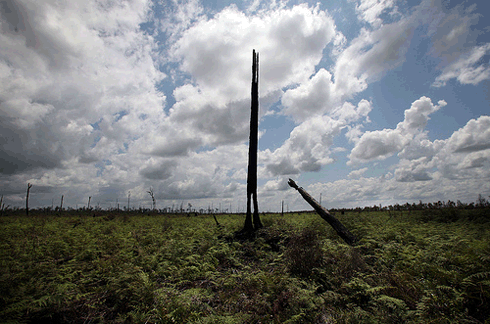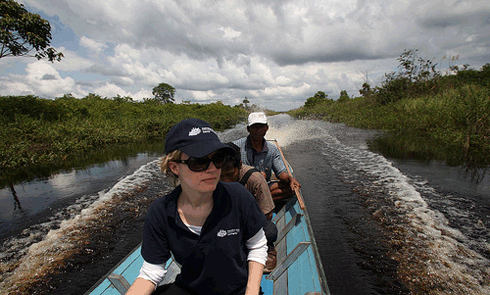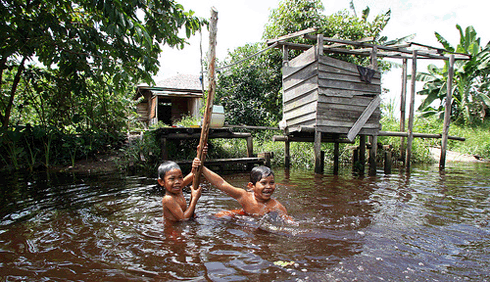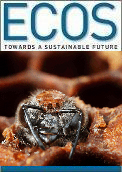
|
Published: 28 May 2012
Indonesia’s peatlands a testground for REDD+
In Indonesia’s Central Kalimantan peatlands, a demonstration project to reduce emissions from deforestation and forest degradation (REDD) is providing valuable lessons for future REDD+ efforts.
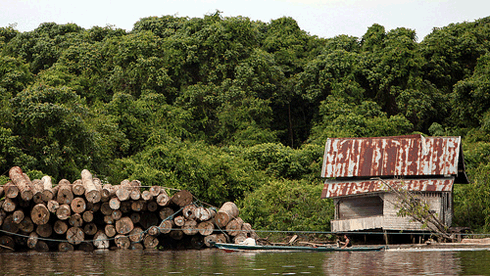
|
|
Local villagers float past a pile of illegally logged trees in Central Kalimantan, Indonesia. Credit:
Josh Estey for AusAID
|
Once home to one of the world’s largest unbroken stretches of tropical peatlands, Indonesia’s Central Kalimantan region has suffered badly from environmental mismanagement in recent years. Its devastated peatlands are now the focus of an Australian–Indonesian restoration effort that is using the region as a demonstration project for reducing global carbon emissions.
By any measure, Indonesia’s Mega Rice Project of 1996 was a spectacular flop. Initiated by former president Suharto, the aim was to transform around one million hectares of tropical peatland in central Kalimantan into rice paddies. This meant eliminating the forest and all its native animal residents – including a large population of orang-utans – and draining the swampy peat using a network of canals.
In 1997, the combination of dried-out peat, drought, and fires lit to clear the land of trees set large areas of peat on fire, casting a huge pall of smoke over much of the country. In the end, the Mega Rice Project was abandoned without a single rice paddy being planted1.
The ruined peatlands of Kalimantan now present a unique opportunity for a climate change mitigation approach known as REDD+, or Reducing Emissions from Deforestation and forest Degradation. The ‘+’ represents additional activities, such as reforestation and sustainable management of forests.
The idea behind REDD+ is straightforward. Deforestation contributes around 18 per cent of global greenhouse gas emissions, so restoring an area that has been deforested – or preventing an area of forest from being chopped down – can reduce overall global carbon dioxide emissions. These ‘carbon credits’ may eventually be traded on the carbon market.
The appeal of REDD+ in developing countries is that in theory, it is easier and cheaper for developed nations to invest in avoided deforestation in the developing world than to reduce greenhouse gas emissions in their own back yards.
The Kalimantan Forests and Climate Partnership (KFCP) was announced in 2007 amid much fanfare. It later formed the basis of the $40 million Indonesia–Australia Forest Carbon Partnership agreed between then Prime Minister Rudd and President Yudhoyono in 2008.
According to the head of AusAID’s climate change program in Indonesia, Sara Moriarty, the Kalimantan peatlands are an ideal demonstration ground for REDD+.
‘A large proportion of Indonesia’s greenhouse gas emissions come from peat,’ says Ms Moriarty. ‘This is why it was specifically targeted as a project site, so that it could demonstrate both the science around emissions reduction in peatland and make a contribution to reducing the emissions from the degraded peatland.’
The KFCP was not initially conceived as a demonstration project, Ms Moriarty says. But, with a change in Australian governments and a shift in the Indonesian government’s priorities towards demonstration projects, the scale and objectives of the KFCP were revised.
‘When they did the design process in 2008 and early 2009, they realised that in order to demonstrate REDD+ in Indonesia, you didn’t need to have such a huge scale, but should focus on testing REDD+ at the local level, which if successful could later be scaled up,’ Ms Moriarty explains. ‘That’s why the targets were revised.’
The Kalimantan project engages the local community to help restore the peatlands by blocking up the artificial canals and replanting the forest.
‘When we actually start the larger-scale canal blocking, the community will be paid for their labour in assisting with the work,’ Ms Moriarty says. ‘The community is also paid for growing seedlings and then planting those seedlings out in the KFCP area. We’ve now planted 1.2 million seedlings that the community have grown.’
Tropical peatlands are particularly appealing for REDD+, because they contain such high concentrations of carbon, says CSIRO’s Pep Canadell, Executive Director of the Global Carbon Project .
‘We have a lot of peat in cold regions, but cold regions have mosses or they have short trees,’ says Dr Canadell. ‘Here, we can have 10 metres of peat and we can still have 30-metre tall trees.’
Unfortunately, just as the potential rewards of tropical peatlands are high, so too are the challenges. One of these is the issue of measuring the change in carbon stocks associated with a program such as KFCP.
The more conventional tropical forest REDD+ projects have well-established, reasonably accurate methods for measuring and calculating changes in carbon stocks. However, in peatlands, the technology for measuring these changes is still fairly crude. Essentially, it comes down to sticking poles in the ground and measuring changes in the depth of the peat.
Given the uncertainty inherent in measurements of carbon stocks and flows in tropical peatlands, will they ever be a potential source of marketable carbon credits? Dr Canadell believes so.
‘You have higher uncertainty, which means that if you want to sell 100 tonnes, you may need to set aside 140 tonnes: and so this means that the cost of a tonne has gone down,’ says Dr Canadell.
While there is concern about that uncertainty, Dr Canadell argues the market should be able to deal with any project that is able to make a meaningful contribution towards reducing greenhouse gas emissions.
‘It’s such a high-carbon-density system that it’s worth really trying to work out a system unique to peat that lets it be included into any REDD developments,’ he says.
Another challenge that the KFCP faced was negotiating through complex and often disputed territorial boundaries among the local populations, to ensure the entire community was properly consulted and onboard with the project.
Stibniata Atmadja, a researcher with the Center for International Forestry Research, has been examining the KFCP as part of a study comparing REDD sites around the world. She says the project is unusually focused on community engagement and on being as participative as possible.
‘I think the process took longer than they expected,’ says Dr Atmadja. ‘Trying to make people understand the point of REDD was very difficult, because it is so different from the normal way of doing things.’
Dr Atmadja says the local community was initially taken aback at being consulted so openly about the KFCP and its aims.
‘They are used to a project saying, “This is what we should do and we need your help doing it”, but in this case, they were asking what [the community] thought,’ Dr Atmadja says.
‘Now they are quite happy to negotiate every single thing, but to get to that point required a lot of communicating and making people understand.’
The community consultation also had to deal with issues of unclear tenure in the area, and land disputes between villages and individuals, which took a long time to fully resolve.
‘Lots of REDD projects may have thought of doing so, but when you actually try to implement that, it takes some effort to do,’ Dr Atmadja says.
The Kalimantan project is one of the largest REDD+ demonstration projects in Indonesia. But, some commentators are suggesting that the project is too small and too slow to be anything more than a gesture in the face of the inexorable juggernaut of deforestation. One such commentator is Professor Stephen Howes, Director of the Development Policy Centre at the Australian National University’s Crawford School of Public Policy.
‘REDD is at a demonstration project stage, so you’re meant to demonstrate through these fairly small projects that you can reduce emissions and then, under REDD, the next phase is you’ll scale it up,’ says Prof. Howes. ‘We don’t think it works, because you can’t deal with those drivers of deforestation through these local projects.’
Prof. Howes argues that more needs to be done at the national government level: changing policies and institutions, as the Norwegian government has attempted.
‘Norway has come along and they’ve put one billion dollars on the table and basically said, “if you can reduce emissions from deforestation, we’ll give you a billion dollars”,’ Prof. Howes says.
Prof. Howes believes this is a better approach, because although it has no greater guarantee of working, it is at least pitched at the national level. He suggests that if REDD demonstration projects such as the KFCP can somehow tap into that higher-level intervention, they may have a role.
‘But, if it continues in this fairly isolated way, then I think gains take so long to accrue, and will be fairly tenuous, and will be somewhat symbolic, or tokenistic against this background of ongoing land conversion and deforestation,’ he says.
Frances Seymour, Director General of the Center for International Forestry Research, acknowledges that this is a key issue with REDD pilot projects.
‘It’s clear that no single project or group of projects will be able to induce the kind of transformational change that REDD actually requires, because the main drivers of deforestation are not the activities of local people in particular villages: they are major economic forces like conversion of forests to oil palm plantations, or the rapid expansion of mining activities in forest areas,’ she explains.
However, Ms Seymour says that REDD demonstration projects can help illuminate those drivers and give a greater understanding of how they play out at the local level. The KFCP in particular is well placed to advance understanding of constraints, such as land tenure insecurity, and the complex relationships among national, subnational and local institutions in land-use planning.
‘KFCP was one of the first projects announced that got started, and so it may be further along in experiencing the challenges of REDD implementation than other pilot projects might be,’ says Ms Seymour.
‘As one of the early movers, it has been very intentional about learning lessons as it moves forward. I think other REDD projects – as well as national-level approaches supported by other donors – can learn from some of that experience.’
More information
Simply REDD: CIFOR's guide to forests, climate change and REDD, Center for International Forestry Research (CIFOR)
Forests absorb one third of our fossil fuel emissions, CSIRO
1 Kalimantan’s peatland disaster, Inside Indonesia, 1 January 2001.


